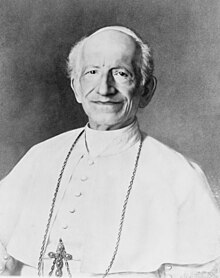Leo XIII | |
|---|---|
| Bishop of Rome | |
 Official portrait, 1898[a] | |
| Church | Catholic Church |
| Papacy began | 20 February 1878 |
| Papacy ended | 20 July 1903 |
| Predecessor | Pius IX |
| Successor | Pius X |
| Previous post(s) |
|
| Orders | |
| Ordination | 31 December 1837 by Carlo Odescalchi |
| Consecration | 19 February 1843 by Luigi Lambruschini |
| Created cardinal | 19 December 1853 by Pius IX |
| Personal details | |
| Born | Gioacchino Vincenzo Raffaele Luigi Pecci 2 March 1810 |
| Died | 20 July 1903 (aged 93) Apostolic Palace, Rome, Kingdom of Italy |
| Motto | Lumen in coelo[1] (Light in Heaven) |
| Signature | |
| Coat of arms |  |
| Other popes named Leo | |
Ordination history of Pope Leo XIII | |||||||||||||||||||||||
|---|---|---|---|---|---|---|---|---|---|---|---|---|---|---|---|---|---|---|---|---|---|---|---|
| |||||||||||||||||||||||
| |||||||||||||||||||||||
Pope Leo XIII (Italian: Leone XIII; born Gioacchino Vincenzo Raffaele Luigi Pecci;[b] 2 March 1810 – 20 July 1903) was head of the Catholic Church from 20 February 1878 until his death in July 1903. Living until the age of 93, he was the oldest pope whose age can be validated, and had the fourth-longest reign of any pope, behind those of Peter the Apostle, Pius IX (his immediate predecessor) and John Paul II.
He is well known for his intellectualism and his attempts to define the position of the Catholic Church with regard to modern thinking. In his famous 1891 encyclical Rerum novarum, Pope Leo outlined the rights of workers to a fair wage, safe working conditions, and the formation of trade unions, while affirming the rights to property and free enterprise, opposing both socialism and laissez-faire capitalism. With that encyclical, he became popularly titled as the "Social Pope" and the "Pope of the Workers", also having created the foundations for modern thinking in the social doctrines of the Catholic Church, influencing the thoughts of his successors. He influenced the Mariology of the Catholic Church and promoted both the rosary and the scapular. Upon his election, he immediately sought to revive Thomism, the theological system of Thomas Aquinas, desiring to refer to it as the official theological and philosophical foundation for the Catholic Church. As a result, he sponsored the Editio Leonina in 1879.
Leo XIII is particularly remembered for his belief that pastoral activity in political sociology was also a vital mission of the church as a vehicle of social justice and maintaining the rights and dignities of the human person. Leo XIII issued a record of eleven papal encyclicals on the rosary, earning him the title of the "Rosary Pope". In addition, he approved two new Marian scapulars. He was the first pope never to have held any control over the Papal States, which had been dissolved by 1870, since Stephen II in the 8th century. Similarly, many of his policies were oriented towards mitigating the loss of the Papal States in an attempt to overcome the loss of temporal power, but nonetheless continuing the Roman Question.
After his death in 1903, he was buried in the Vatican Grottoes before his remains were later transferred in 1924 to the Basilica of Saint John Lateran.
Cite error: There are <ref group=lower-alpha> tags or {{efn}} templates on this page, but the references will not show without a {{reflist|group=lower-alpha}} template or {{notelist}} template (see the help page).
- ^ Gifford, Don (1982). Joyce Annotated: Notes for Dubliners and A Portrait of the Artist as a Young Man. University of California Press. p. 106. ISBN 978-0-520-04610-8.